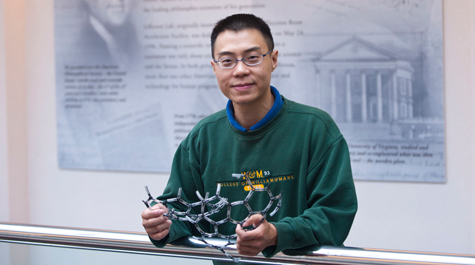J-Lab scientist wins award for graphene invention developed at W&M
Like most inventors, Jefferson Lab scientist Xin Zhao's moment of inspiration was prompted by a need, and the result was an invention that could someday see batteries in electric vehicles and similar devices boosted or replaced by high-power, high-capacity, fast-charge/discharge energy storage systems using graphene.
"After graduation, I was looking for applications for a new material developed by my colleagues at William & Mary," recalled Zhao, who had just graduated from the College of William & Mary with a Ph.D. in materials science. It was 2006, and even before he had a job, he began exploring possible uses for graphene carbon nanosheets.
Better Ways to Store, Use Energy
The material developed at William & Mary "is a carbon nanomaterial, which is made of layers of graphene—one to three layers. It's flat, like a sheet of paper. I thought maybe this material could be used to store energy," Zhao explained. The epiphany spurred an exploration of scientific literature in search for answers. Soon, he became focused on electrochemical double-layer capacitor (EDLC), so-called supercapacitors, or ultracapacitors. Unlike batteries, supercapacitors have a much higher power density—hundreds of times more—and can be charged in seconds.
Zhao designed a supercapacitor that would use graphene, and William & Mary filed for a patent on the invention. In 2010, a patent (U.S. Patent No. 7852612) was granted, opening doors to a plethora of potential commercial applications.
“We are excited about the commercial potential of the technology,” said Jason McDevitt, director of technology transfer at William & Mary.
"It is very special," Zhao said of his invention's first use of vertically standing graphene in a supercapacitor. "There are many applications for graphene-based supercapacitors. Graphene makes the supercapacitors lighter and can increase energy density and power density of these energy storage devices. And also, to build graphene from carbon-enriched gases by plasma-enhanced-chemical-vapor-deposition (PE-CVD) is very low-cost."
Zhao's invention was independently verified by John Miller et al, and further research at William & Mary is funded by DARPA. Early results were recently reported in the Sept. 24 issue of Science Magazine.
Graphene is a two-dimensional form of carbon. It is ultra-thin—just one atom thick—and super-strong. It outperforms copper as a conductor of electricity and also outperforms all known materials as a conductor of heat. In 2010, two University of Manchester scientists received the Nobel Prize in Physics for their work isolating and demonstrating the unique properties of graphene.
Work Earns Tech Award
Zhao's work with graphene-based supercapacitors also has just won him a prize. On Oct. 27, he was named a winner in the individual Energy category by the World Technology Network. He was among the finalists who presented their work on Oct. 26, and he shares the top award with two other co-finalists, who are working on separate approaches to graphene/carbon nanomaterials-based supercapacitors. The award was presented at a ceremony held at the United Nations on Oct. 27.
"It is a great surprise and an honor for me," Zhao said of the award. "Essentially, the motivation for the WTN competition is to help everybody to think, invent and use new technologies to use energy more efficiently, protect our environment, and live a healthy life."
"It was a fun event, where I heard a lot about the achievements and visions of other scientists and inventors," he added. "I hope people pay more attention to this technology, which could really help the nation to save energy, or use energy more efficiently."
The World Technology Network is an organization that brings together individuals, organizations and companies deemed by their peers to be the most innovative in the science and technology world. WTN has more than 1,000 members in 60 countries engaged in 20 categories of research.
“This young man is a dynamo,” said Ron Outlaw, research professor in William & Mary’s Department of Applied Science, said of Zhao. “Whatever the scientific objective, he pursues it with great tenacity and intelligence. As my Ph.D. student, he made major contributions is several scientific areas.”
Outlaw still collaborates with Zhao, part of a Jefferson Lab team working on a Department of Energy project to develop niobium thin-film coatings for superconducting radiofrequency (SRF) accelerator cavities.
Zhao joined Jefferson Lab at the suggestion of his wife, Hui Tian, a member of the SRF Institute who at the time was working at the Institute as a W&M Applied Science Department Ph.D. materials scientist candidate. She was convinced that his expertise in materials science could help the lab develop new technologies for particle accelerators like the lab's Continuous Electron Beam Accelerator Facility.
Since joining the lab in 2007, Zhao has been applying his expertise in materials analysis, characterization and fabrication in the development of better accelerator materials. He explores the microstructure, nanostructure and surface characteristics of accelerator cavities, in hopes of helping to develop more efficient, low-cost accelerators.
















